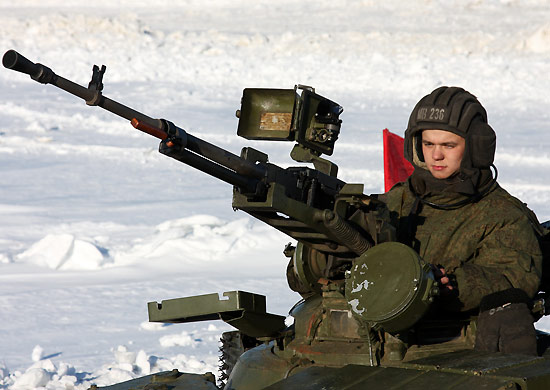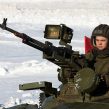
Russian Army Intensifies Combat Training
Publication: Eurasia Daily Monitor Volume: 9 Issue: 135
By:

As the summer combat training period intensifies for the Russian Army, supporting programs and changes to the training schedule suggest that greater attention is being given to improving its quality. Commanders in the Central Military District (MD) report that subunits will remain in the field if they only achieve satisfactory results, as part of a wider effort to raise combat training standards. This approach is also coupled with efforts to increase the proficiency of non-commissioned officers (NCOs) and kontraktniki (contract personnel), while experiments aimed at enhancing officer training are ongoing (Krasnaya Zvezda, July 12).
The press service of the East MD reports that more than 90 percent of around 8,000 kontraktniki have received certificates confirming that they have successfully completed combined-arms training courses in training centers in Transbaikal and Khabarovsk. The training provided in these centers was specially designed for servicemen from different branches and arms of service to test and improve levels of professionalism. The kontraktniki attending the courses studied the practical essentials of “tactical, fire, reconnaissance, engineering, military medical, and physical training, military topography, and methods of protection against radiation, chemical and biological weapons,” in addition to a basic survival course. On July 2, a second batch of 4,500 kontraktniki began similar courses with additional elements, including a forced crossing of a water obstacle (Krasnaya Zvezda, July 15).
Similarly, in Western MD the training of NCOs and kontraktniki has also shifted toward more field work and efforts to train personnel for “independent actions in accomplishing combat assignments.” The Defense Ministry wants to build the capability of such personnel to meet challenging tasks and raise morale and unit cohesiveness. The rehearsed “combat operations” were staged mainly in forests, with participants having to prepare overnight camps using makeshift materials, procuring their own water and food, conducting reconnaissance and search operations, repelling commando raids, and navigating without instruments. However, the most unusual feature of the training was that any kontraktniki failing to cope with the course or meet high standards, or engaging in the hazing of other personnel were examined before review boards and discharged from service. By the end of July, more than 3,000 kontraktniki will have attended such courses in eleven training centers in Western MD, and by the end of the year, all NCOs and kontraktniki in the MD will have undergone such training (Regnum, July 4).
According to the Chief of the Training Department of the Central MD Missile Troops and Artillery Directorate, Colonel Gennadiy Mandrichenko, the documents governing combat training require soldiers to stay in the field if they score satisfactory levels or less during their training. While commanders welcome such fresh approaches in order to raise overall standards, there are still some deep problems in the system, particularly linked to training motorized rifle commanders to retain control over attached fire-reinforcement units. Mandrichenko notes that combined-arms battalion commanders seldom know how to organize joint operations with artillery subunits at their disposal. He believes it is difficult to ascertain how comprehensively trained the personnel are in real terms, with motorized rifle commanders often trained in isolation from artillery subunits. Mandrichenko adds, “The topic of artillery fire control once again puts not only company and battalion commanders, but even higher-ranked commanders, in a difficult position. It is not by chance that special attention was given to this issue during the field training-methodological assembly of artillerymen that took place this year at the Totskiy District Combined-Arms Range, in the process of which commanders of motorized-rifle formations of the 2nd Guards Army invited to the assembly were given the opportunity to perform artillery-formation fire-control missions. Based on the results that we were able to observe, we artillerymen would like to see a much greater understanding of the role and significance of artillery support in a combined-arms battle by the commanders of combined-arms formations” (Krasnaya Zvezda, July 12).
According to the Moscow Defense Brief, on April 2, 2012, the Defense Ministry tendered a contract to “develop a concept for improving the system of officer training” in the Armed Forces. The contractor is required to analyze and assess existing programs, identify problems in the system of training and re-training, and develop a conceptual basis to improve officer training, supporting the Defense Ministry’s transition to higher standards in professional education for officers (Moscow Defense Brief, No. 3, 2012). Although the Defense Ministry actions in undertaking this initiative indicate that serious attention is being devoted to improving the system of officer training, it also appears to denote little vision or understanding within the ministry on how to achieve these targets, more than three years after launching systemic reform in the Armed Forces.
However, as the modernization of the Armed Forces continues on the basis of the State Armaments Program to 2020, the need for further improvements to the manning and combat training system is likely to increase. At this stage, the Russian Defense Ministry seems to be experimenting with the type of training systems it will need in the future. According to Aleksei Nikolski, defense correspondent for Vedomosti, the more than 20 trillion rubles ($614.2 billion) earmarked for the rearmament program contains 4 trillion rubles ($122.84 billion) on “unknown weapons.” President Vladimir Putin recently stated that the Ground Forces and the Airborne Forces will receive 2.6 trillion rubles ($79.84 billion) from this program. Modernizing the Navy will cost 4.7 trillion rubles ($144.33 billion), and 4 trillion rubles will go for military space and air defense, while the Air Force will receive another 4 trillion rubles. Although expenditure on the Strategic Rocket Forces (Raketnye Voyska Strategicheskogo Naznacheniya – RVSN) is secret, it is not expected to total more than 1 trillion rubles ($30.7 billion). Various Defense Ministry officers and experts have speculated on the nature of spending allocated to the remaining 4 trillion rubles, but the likelihood is that it will be spent on developing military infrastructure (Vedomosti, July 13). What is remarkable about the projected rearmament spending is that the Ground Forces seems to be the poor cousin in the process.
Nonetheless, as the procurement of new and modernized weapons systems and equipment appears in the Ground Forces, the process of developing commensurate combat training programs and raising overall professional standards is likely to continue. Yet, based on the experience of these programs by some commanders, there is a long way to go before the system offers truly joined up training capable of fully integrating all command elements.




